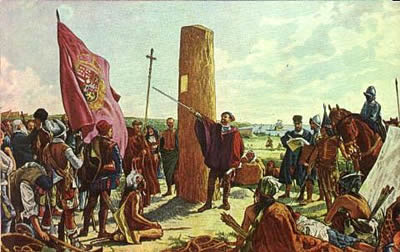Repartimiento in Spanish America
 |
| Repartimiento in Spanish America |
Rooted in the verb repartir (to distribute, to allot), repartimiento in Spanish America refers to two distinct institutional practices. One relates to encomienda during the first century of colonization, the second to the forced sale of Spanish goods to Indian communities, which occurred primarily during the late colonial period.
With respect to the first, repartimiento and encomienda were legally distinct but functionally identical. In both cases the term referred to the official allotment or distribution of Indians to specific Spaniards under conditions of forced or coerced labor. The practice was also known locally by different names, including coatequitl in New Spain and mita in Peru.
The forced-sale meaning of the term, also called reparto de comercio, or simply reparto, referred to an increasingly common practice during the mature colonial period, particularly as the royal treasury grew strapped for cash and local officials came to depend on revenues from forced sales to maintain their standards of living.
Local officials such as alcaldes, corregidores, and others, in effect foisted excess goods on Indian communities—goods either imported from Spain or locally produced—by requiring their purchase, making repartimiento, in effect, one more form of taxation that drained surplus labor and production from Indians.
Vigorous denunciations of the abuses of repartimiento from visiting inspectors and officials repeatedly crossed the royal desk, to little practical effect. One, penned in the 1730s and referring to repartimiento in the province of Quito, described the system as “so cruelly wicked that it appears as if it were imposed on those people as a punishment ... a more tyrannical abuse could not be imagined.â€
Fiscal constraints meant that leading officials largely ignored this and many similar condemnations. In the 1750s, the Crown legalized the practice, and in many areas it continued for the rest of the colonial period.
Some scholars hypothesize that excessive impositions of repartimiento constituted an important contributory factor in sparking the major uprisings and revolts that rocked the Andes from the 1730s to the 1780s. Others have traced more localized revolts, in New Spain and elsewhere, to the practice. In essence, repartimiento was one more mechanism by which local officials and the colonial state extracted surplus labor from Indians.
- Caciques In Latin America
Caciques in Latin America Cacique (ka-SEE-kay) is an umbrella term designating a wide variety of indigenous forms of political rule in pre-Columbian and postconquest Latin America, particularly Spanish America. In the Andean highlands, the equivalent...
- Mita Labor In The Andean Highlands
For many centuries prior to the Spanish conquest, the indigenous peoples of the Andean highlands had employed a system of reciprocal labor exchange known as mita (MEE-ta). Literally translating as “turn work†or a “turn†of labor,...
- Obrajes In Colonial Latin America
Obrajes in Colonial Latin AmericaObrajes (roughly, workshops) were key enterprises in the developing economies of Spain’s American colonies, principally as sites where wool, cotton, and other fibers were carded, spun, and woven into textiles. While...
- Viceroyalty Of Peru
The largest and second most important political jurisdiction in Spain’s American empire after the Viceroyalty of New Spain, the Viceroyalty of Peru came into being in 1542 during the civil wars that wracked the Andes during the conquest of Peru....
- Francisco De Toledo - Spanish Viceroy Of Peru
The most important reformer of Spanish administration in the newly conquered Andean highlands during the early colonial period, Francisco de Toledo, in his capacity as viceroy of Peru (1569–81), was instrumental in the transition from the violence...
